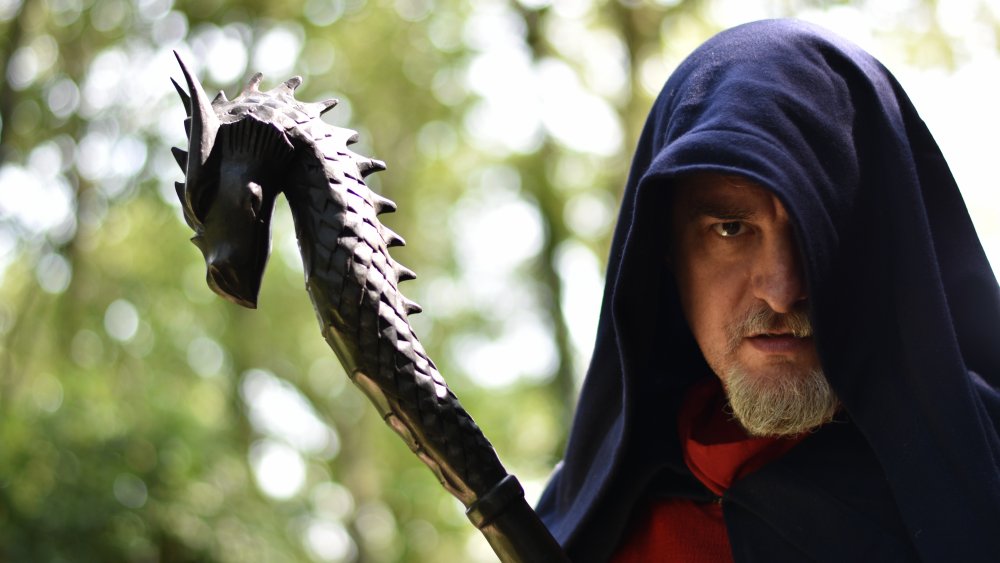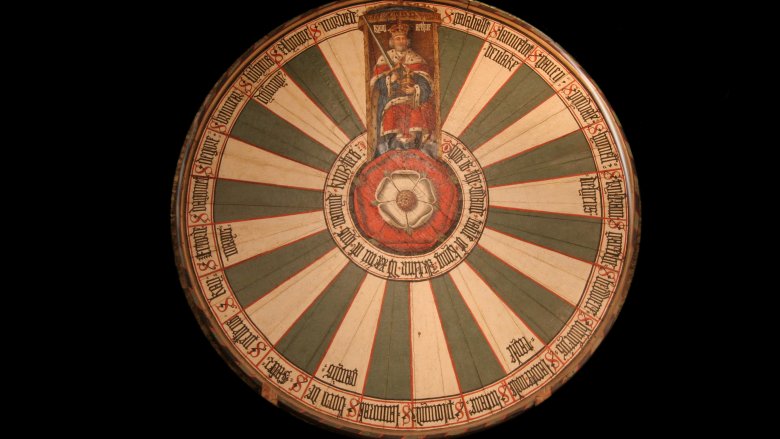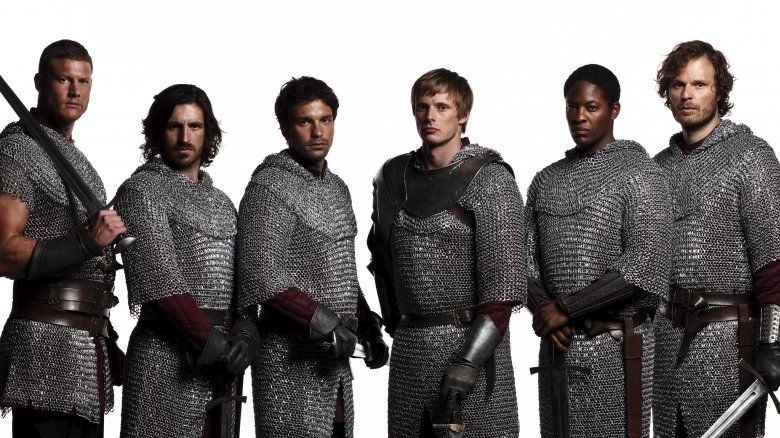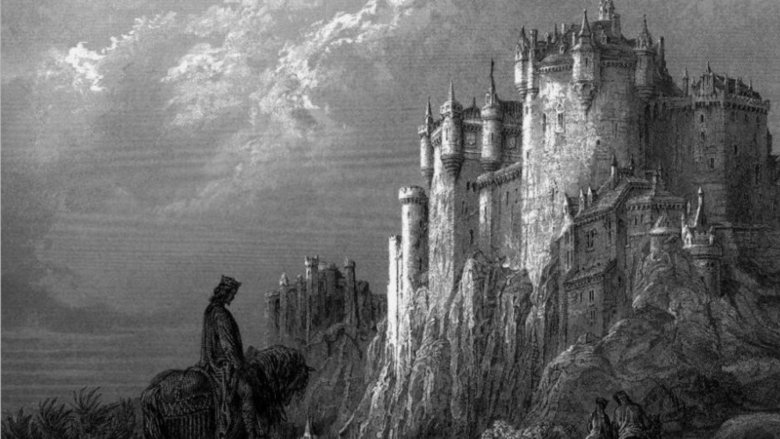False Things You've Always Believed About The King Arthur Legend
We may receive a commission on purchases made from links.
Few mythologies are more familiar to the Western world than the legend of King Arthur. In one form or another, we all recognize the fable: a dashing king, a dangerous love triangle, a band of noble knights committed to ridding the land of invaders. Never mind that most knights were brutal tyrants, most kings were inbred jerks, and women were akin to property in the Dark Ages — hence, the reason no one refers to that time period as the "Enlightened Times." Legends, unfortunately, often find themselves at odds with history, as fact and fiction can conflate over time and through retelling. As a result, the storied tale of the King of the Britons is party to more than a handful of inaccuracies.
Merlin the Magician has no historical basis
One of the classic players in the Arthurian saga was, of course, Merlin the Magician. But while no one disputes that there weren't actual wizards running around England several centuries ago, we need to go a step further. Merlin may be nothing more than pure fiction.
Some scholars, such as English author Nikolai Tolstoy — a distant cousin to the War and Peace guy — believe Merlin's character may have been based on a historical figure. Any valid ancestry, though, is likely a combination of the mythic Welsh bard Myrddin the Wild and Ambrosius Aurelianus, a Romano-Celtic warlord. Tolstoy theorizes in his 1985 book, The Quest for Merlin, that the wizard was originally a Welsh or Scottish figure from the 6th century, possibly a druid, while others believe his character is based on pre-Dark Ages pagans or even a Scottish Christian who lived during the era.
Despite the minor discord, the historicity of Arthur's on-staff wizard remains dubious at best. His late placement in Arthurian legend has led many to believe he's pure fabrication, especially since the Arthurian tales were born during the 9th century and Merlin doesn't enter into of the lore until 1136 — in Geoffrey of Monmoth's Historia Regum Britanniae. It's not until later iterations that he gains his wizardly powers and dramatic import in the saga. Seeing as Historia is partially unspooled through the voice of Merlin, contemporary historians like Medievalist Anne Lawrence-Mathers feel he's merely the byproduct of an author trying to spice up his otherwise dry tome.
The Round Table wasn't an actual table
Popular culture paints a very literal picture of the court of Camelot sitting around the Round Table...because, well, how else is there to depict a bunch of knights kicking it with the king? But in truth, the "Round Table" was likely more of a metaphor than an actual place to eat dinner and talk about quests and stuff.
Arthur's fabled Round Table was probably more of a meeting place. According to Arthurian historian, Chris Gidlow, the "table" itself was a large venue, similar to a Roman coliseum, capable of holding up to 1,000 people. Later, festivals named "round tables" sprung up around the legend, which consisted of all the usual Renaissance Fair-type fare, including jousting, sword-fighting, knightly carousing, and obscene consumption — at least compared to the extreme poverty of the general populace.
It's easy to understand where our faulty notion comes from, too. TV, film, and art often misinterpret the venue, conflating the legendary plateau with medieval art objects like the Winchester Table. According to Atlas Obscura, the famous green and white mockup that hangs in the Great Hall of Winchester Castle was actually constructed in the 1300s by King Edward I's daughter. That, of course, is already a few hundred years after the Legend of King Arthur was first recorded.
Sir Lancelot is a "recent" addition to the court at Camelot
Sir Lancelot's known as one of King Arthur's best buds, charging off into battle, smiting his king's adversaries, and rescuing damsels in distress — well, usually Arthur's main squeeze, Queen Guinevere anyway. Of course, as the story goes, he also fell in love with the queen and betrayed King Arthur for her. However, many aspects of the fabled cavalier are probably nothing more than, well, fables.
While first hints of the King Arthur tale date back to the 5th century A.D., Lancelot doesn't partake in the questing until at least the 12th century. The knight doesn't even bear a mention until the works of French poet and troubadour Chrétien de Troyes. Although he's present in numerous historical documents, movies, books, and even a few action figures, the renowned knight is probably just a fabrication of de Troyes, rather than an actual member of Arthur's Round Table.
Still, there is some basis for Lancelot in ancient folklore. Scholar Roger Loomis believed the hero had links to Celtic mythology, in particular, the sun god Lluch Llauynnauc. Meanwhile, Dr. Thomas Asbridge of Queen Mary, University of London theorizes Lancelot's bromance with Arthur was inspired by accounts of King Henry the Young and William Marshal — a somewhat historical tale of a king-to-be and his knightly mentor, who got freaky with the king-to-be's wife. Translating Henry's tale into early Lancelot fiction is unsurprising, as even during the Dark Ages, everyone loved a juicy scandal.
The knights of Round Table were a diverse bunch
The common conception of the Knights of the Round Table is usually that of a bunch of pasty white guys wearing metal pantaloons, clattering off to swipe a shiny cup (the Holy Grail) from a bunch of heathens (anyone not Christian). In truth, the mythological band may have been somewhat more diverse than movies have depicted them — like in 1995's First Knight starring Sean Connery and Richard Gere, or the 2004 Keira Knightly epic, King Arthur. Yet, the recent Guy Ritchie box office flop, King Arthur: Legend of the Sword, almost got the casting right, as does the British fantasy show, Merlin, whose cast is pictured above.
Some early manuscripts depict at least one if not several members of the courtly band as non-Caucasian. Round Tablers were depicted as Moorish — a multiethnic group that typically hailed from Africa and spread through Spain, Portugal, and Italy — or Middle Eastern. In particular, according to an article published by the Smithsonian, a knight named Morien is described thusly: "his head, his body, and his hands were all black," whose armor and shield were also described as similar to those of the Moors. Several other members of Arthur's court, such as Palamedes, were labeled as a "Saracen," which referred individuals of Arabic or Muslim descent — although the Islamic faith didn't take hold until after the Arthurian era. Overall, it sure looks like King Arthur was down with equal representation.
King Arthur might not even be British
While some aspects of King Arthur's story are open for debate, one detail is usually agreed upon: Arthur's English. Right? Well, as it turns out, Arthur may not have been King of the Britons at all.
Loosely historical references vary wildly, but some scholars, like Geoffrey Ashe, believe Arthur was based on an actual military leader from the 5th or 6th century. Ashe himself equates the fabled royal to possible Breton or Romano-British warrior Riothamus. Other historians consider Arthur to be inspired by either Roman military leader Lucius Artorius Castus or Ambrosius Aurelianus — who repelled the Anglo-Saxon invasion of the island nation — or a relative of either figure. It's also possible the iconic king was actually based on Welsh warrior or nobleman or that Arthur's name also itself was specifically chosen to honor the Celtic warrior bear-god Artos or Artus, as well as aspects of their mythology. There are even parallels between the classic mythos and Sarmatian tribes, original of Iranian region, including references to a sword lodged in a pile of wood and possibly forged by a tribal swordsmith known as a Kalyber. Still others, such as Dr. Andrew Breeze, feel that evidence points to Arthur living and fighting his battles in Scotland or Northumberland, leading some to believe he was from North Briton.
Despite curious evidence for many of these theories, proof of origin of is difficult to come by without more ancient records and artifacts to cross-check. Conclusively pegging the "once and future king" as a Brit remains improbable.
Camelot could be real but King Arthur probably didn't live there
Camelot, King Arthur's legendary home, seems to be a relatively recent addition to the Arthurian tales. The earliest accounts of a mighty fellow named Arthur made no mention of the mythical castle. In fact, the first references to the storied domain don't arrive until 1136, when "historian," Geoffrey of Monmouth mentioned it in his Historia Regum Britanniae. According to the University of Rochester's Camelot Project, the legendary land wasn't linked to King Arthur until the poems of Chrétien de Troyes, several decades later. In his tales, though, the king was said to have actually ruled from the Welsh city of Caerleon, with Camelot merely serving as part of his territory. It wasn't until the "Vulgate Cycle" of French poems, which also emphasized the Grail quest, that Camelot grew to resemble its current import.
Even if Arthur never called Camelot home, the fantastical fiefdom may actually connect with a historical castle, although no one seems to be able to agree on where it is. Recent discoveries equate Caerleon itself with Camelot, as well as Cadbury Castle in Somerset, England, and a Roman fortification in West Yorkshire. Will the true historical location, where the legendary king might have lived, ever be discovered? Perhaps. Even if it is, let's not go there. 'Tis a silly place.
King Arthur may not have existed
So, after all this, was King Arthur even real at all? Historians, amateur Medieval enthusiasts, and even scientists have performed numerous comprehensive studies exploring the legend of Arthur and peering behind the veil (rude!) of antiquity to determine whether he actually existed. To this day, no one's actually certain.
History's earliest mention of the storied noble came in the sixth-century compendium, Annales Cambriae, although his most extensive early reference extends from the eight-century work of Welsh historian Nennius, the Historia Brittonum, where Arthur appears as something of a warlord. An article published by the History Channel explains that his name also appears, scattershot, throughout poetry and prose documents, such as Geoffrey of Monmouth's "History of the Kings of Britain," who first included the fabled king in his work. When put all together, it seems likely that Arthur is probably a composite character, cobbled together from Celtic mythology, Welsh and Roman-Briton history, and French legend.
Despite his dubious ancestry, King Arthur probably was actually based upon a real figure or figures. Astounding proof of his existence isn't as important as the mythological figure he became. Arthur's legend is so deeply ingrained into our culture, he's become an archetype — albeit one with more than a few outdated values. Anachronistic or not, his impact on our culture gives Arthur a lasting legacy and life of his own.




